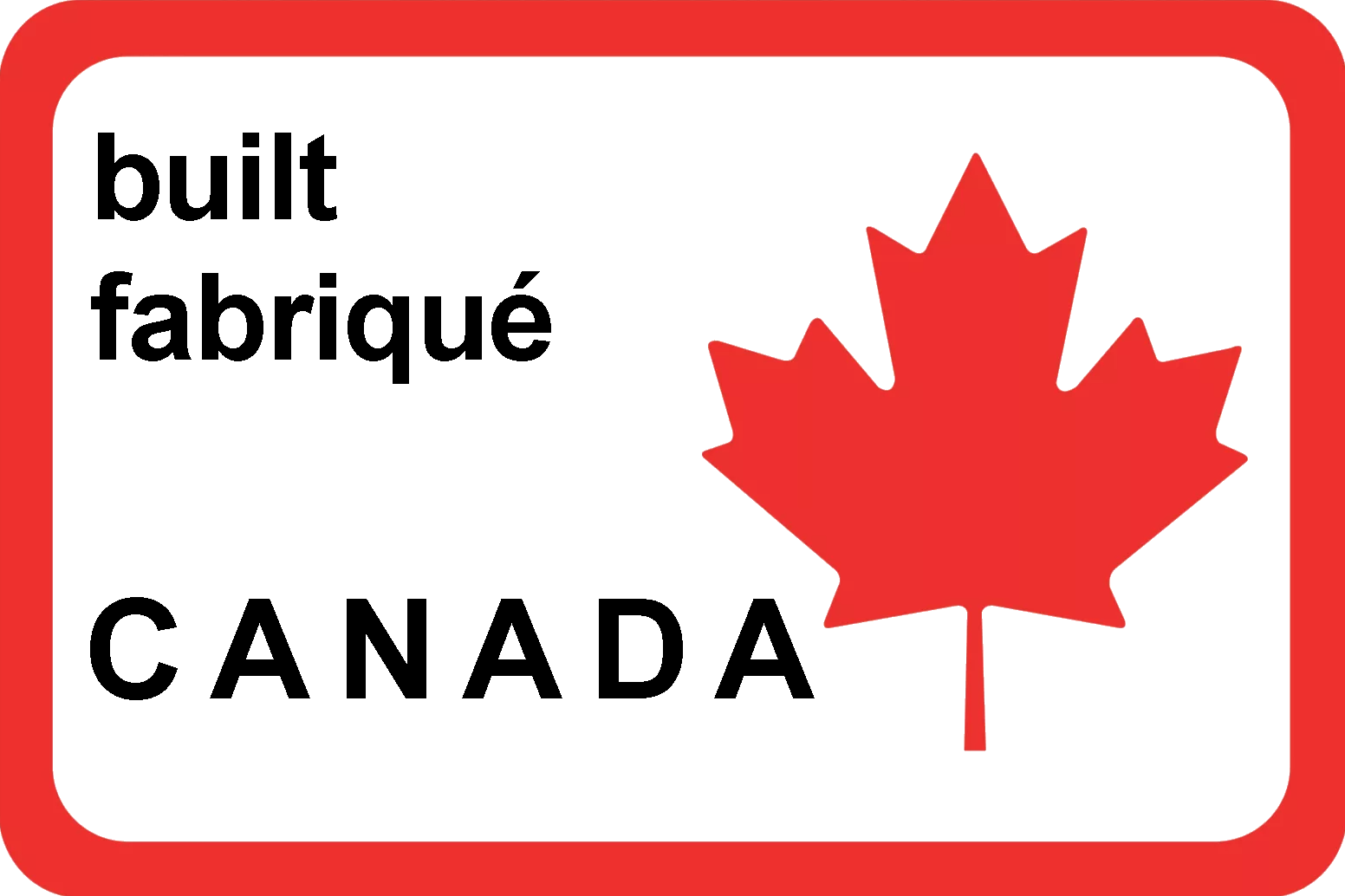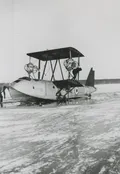Vancouver (Total: 6, Canadian: 6, Group 0)
Canadian Vickers Vancouver

Canadian Vickers Vancouver, RCAF (Serial No. 903), No. 4 (Flying Boat) Squadron, 19 Aug 1936
The Canadian Vickers Vancouver was a Canadian transport/patrol flying boat of the 1930s built by Canadian Vickers. It was a twin-engine, equal-span biplane. The hull was of metal and the rest of the structure of fabric-covered wood.
The Vancouver was developed as a replacement for the Varuna in response to a Royal Canadian Air Force requirement for a flying boat to transport men and equipment to forest fires. The main difference from the Varuna was a duralumin hull and more powerful engines. The two flight crew were located in two tandem open cockpits, forward of the wing. The main cabin could accommodate a firefighting team of six men and all the required equipment. Five aircraft were delivered to the Royal Canadian Air Force, one was later converted into a coastal patrol aircraft.
In the mid-1930s, the Vancouvers were modified as coastal patrol aircraft by the installation of machine guns and bombs.
After the outbreak of the Second World War, Vancouvers served with 4 Squadron, RCAF at Jericho Beach Air Station until withdrawn from service in 1940. After a brief period of service in training duties, they were finally withdrawn and struck off in 1940. None of the aircraft saw service after 1940. Wikipedia
Vancouver II, IIS/W serial 902
s/n 902
c/n CV164

Canadian Vickers Limited
902
Serval, Wright J-6E
Known Units: 4; 13
Taken on strength at Ottawa Air Station on 16 July 1930 as G-CYVQ. Sent to Winnipeg on 27 July 1930 and from there to Ladder Lake SK on 29 July 1930. Also operated from Cormorant Lake that summer. Repairs to hull completed in Winnipeg on 14 September 1931. Returned to Ottawa by 31 May 1932. As part of an air mail service to Ottawa, flew mail from incoming liners at Belle Isle, Labrador to Havre St. Pierre, QC, as well as the Havre St. Pierre to Rimouski leg, during Imperial Economic Conference, summer of 1932. Back at Ottawa Air Station on 17 October 1932. Sent to Canadian Vickers and refitted with Armstrong Siddeley Serval engines, completed 31 August 1933 and returned 1 Depot in Ottawa. Renumbered to 902 by 30 June 1935. Reconditioning completed at 1 Depot by 31 July 1935. Stationed with 4 (FB) Squadron, later 4 (BR) Squadron, RCAF Station Jericho Beach, BC, from 31 March 1936. Refitted with Wright J-6E 975W engines to become IIS/W variant. Reconditioning completed at Wells Air Harbour, Vancouver, on 3 April 1939. Category C crash with 4 (BR) Squadron on 15 October 1939. Assigned to Western Air Command as part of 13 (OT) Squadron, RCAF Stations Sea Island or Patricia Bay, BC, from 1 April 1940. Withdrawn from service after 765 total flying hours (136 hours since last overhaul) on 25 November 1940 as a complete write-off.source: Kestrel Publications
last update: 2025-November-19
1935-June-30 Serial Change Renumbered from G-CYVQ 2019-08-20
1939-October-15 Accident Category C 2025-04-04
1940-November-25 Struck off Strength 2019-08-20
Vancouver II, IIS/W serial 903
s/n 903
c/n CV165

Canadian Vickers Limited
903
Serval, Wright J6E
Known Units: 4; 13
Taken on strength at Ottawa Air Station as G-CYVR on 24 July 1930. Sent to Winnipeg on 27 July 1930 and from there to Lac du Bonnet MB on 29 July 1930. Back at Ottawa Air Station on 31 May 1932. Provided air mail service from incoming liners at Belle Isle, Labrador to Havre St. Pierre, QC during Imperial Economic Conference, summer of 1932. Sent to Canadian Vickers for modifications, completed 6 June 1933 and returned to Ottawa. Renumbered to 903 by 30 June 1935. Refitted with Armstrong Siddeley Serval engines at 1 Depot in Ottawa by 26 May 1936. With 4 (FB) Squadron, later 4 (BR) Squadron, RCAF Station Jericho Beach, BC, from 24 September 1936, coded "FY*D". Seen at RCAF Station Trenton, Ontario, on 2 February 1938. Refitted with Wright J-6 975W engines in Vancouver to become IIS/W variant. Assigned to Western Air Command as part of 13 (OT) Squadron, RCAF Stations Sea Island or Patricia Bay, BC, 1 April 1940. Withdrawn from service after 653 total flying hours (272 hours since last overhaul) as a complete write-off on 25 November 1940.source: Kestrel Publications
last update: 2025-November-19
1935-June-30 Serial Change Renumbered from G-CYVR 2019-08-20
1940-November-25 Struck off Strength 2019-08-20
Vancouver II, IIS/S serial 904
s/n 904
c/n CV166

Canadian Vickers Limited
904
Lynx
Known Units: 4
Taken on strength as G-CYVS on 28 August 1930. Fitted with geared Armstrong-Siddeley Lynx engines. With 4 (FB), later 4 (BR), Squadron, RCAF Station Jericho Beach, BC, 1933 to 1939. Renumbered to 904 by 30 June 1935. Armed by October 1938 as IIS/S. May have later served at seaplane school. Withdrawn from service after 529 total flying hours (328 hours since last overhaul). Ginger Cootes Airways attempted to buy airframe in October 1940, but the offer was refused. Engines were used for instructional purposes after aircraft was struck off, sometime at the end of 1940.source: Kestrel Publications
last update: 2025-November-19
1935-June-30 Serial Change Renumbered from G-CYVS 2019-08-20
1940 Struck off Strength 2019-08-20
Vancouver II serial 905
s/n 905
c/n CV167

Canadian Vickers Limited
905
Lynx
Known Units: 4
Taken on strength as G-CYVT on 15 August 1930. Fitted with geared Lynx engines. Used at Lac du Bonnet, MB. With 4 (FB) Squadron, RCAF Station Jericho Beach, BC, from 1933. Renumbered to 905 by 30 June 1935. Damaged on 5 February 1936, when it dragged its anchor during a storm and beat itself to pieces against a dock belonging to the Vancouver Yacht Club before sinking in 20 feet of water. Engines were salvaged but the airframe was not repaired. Had 369:40 logged time when struck off on 5 May 1936.source: Kestrel Publications
last update: 2025-November-19
1930-August-15 Taken on Strength 2022-02-07
1935-June-30 Serial Change Renumbered from G-CYVT. 2019-08-20
1936-May-05 Struck off Strength 2019-08-20
Vancouver II, IIS/S serial 906
s/n 906
c/n CV168

Canadian Vickers Limited
906
Lynx, Serval
Known Units: 4
Taken on strength as G-CYVU on 2 September 1930. Fitted with geared Lynx engines. Renumbered to 906 by 30 June 1935. Converted to armed Service Standard as Mk. IIS/S. Refitted with Armstrong Siddeley Serval engines. With 4 (FB) Squadron, later 4 (BR) Squadron, RCAF Station Jericho Beach, BC, 1933 to 1939. Struck off by the end of 1940.source: Kestrel Publications
last update: 2025-November-19
1930-September-02 Taken on Strength 2022-02-07
1935-June-30 Serial Change Renumbered from G-CYVU. 2019-08-20
1940 Struck off Strength 2023-05-04
Vancouver I, IA serial G-CYXS
s/n GCYXS
c/n CV107

Canadian Vickers Limited
G-CYXS
Lynx/Wright J6E
Known Units:
First Vancouver prototype initially civil registered as G-CYXS. Accepted by RCAF and taken on strength on 23 August 1929. Used for initial acceptance tests at RCAF Station Ottawa. Reported to have been fitted with geared Armstrong-Siddeley Lynx IV engines although the Aircraft Record Card indicates Wright J-6E engines. Partially modified to Mk. II standards in 1930 as Mk. IA (Lynx IVC engines) but was considered uneconomical to convert to full military standard. Reduced to produce in Ottawa by 3 October 1934. Instruments, engines, and other components were salvaged and returned to the Depot.source: Kestrel Publications
last update: 2025-November-19
1929-August-23 Taken on Strength 2022-02-07
1934-October-03 Struck off Strength reduced to spares and produce 2023-05-03





















































